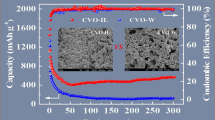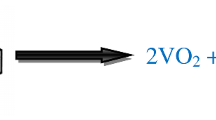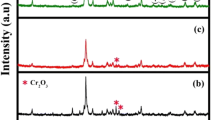Abstract
Molecular cluster ion compound K7NiV13O38 (KNiV) has been studied as a novel cathode material for lithium ion battery. The nanoparticles are prepared by a simple re-crystallization method adding different volumes of acetone to the water solution containing the dissolved KNiV. The KNiV re-crystallized from water/acetone ratio of 1:5 shows the most uniform particle size distribution and the smallest particles with thickness of ~100 nm and width of ~150 nm. The nanoparticle KNiV shows significant improvement in initial discharge capacity and capacity retention after 50 cycles compared to the as-prepared micro-sized particles at various current densities. Ex situ XRD patterns demonstrate that the discharge–charge process proceeds with amorphous KNiV, which is independent from the crystal structure. Ex situ FT-IR spectra indicate that [NiV13O38]7− cluster ion is stable and reacts reversibly with lithium ion in the discharge–charge process.










Similar content being viewed by others
References
Basa A, Gonzalo E, Kuhn A, García-Alvarado F (2012) Reaching the full capacity of the electrode material Li3FeF6 by decreasing the particle size to nanoscale. J Power Sources 197:260–266
Cooper JM, Cubitt R, Dalgliesh RM, Gadegaard N, Glidle A, Hillman AR, Mortimer RJ, Ryder KS, Smith EL (2004) Dynamic in situ electrochemical neutron reflectivity measurements. J Am Chem Soc 126:15362–15363
Ellis BL, Lee KT, Nazar LF (2010) Positive electrode materials for Li-ion and Li-batteries. Chem Mater 22:691–714
Imanishi N, Morikawa T, Kondo J, Takeda Y, Yamamoto O, Kinugasa N, Yamagishi T (1999a) Lithium intercalation behavior into iron cyanide complex as positive electrode of lithium secondary battery. J Power Sources 79:215–219
Imanishi N, Morikawa T, Kondo J, Yamane R, Takeda Y, Yamamoto O, Sakaebe H, Tabuchi M (1999b) Lithium intercalation behavior of iron cyanometallates. J Power Sources 81–82:530–534
Jeannin Y, Launay JP, Seid Sedjadi MA (1980) Crystal and molecular structure of the six-electron-reduced form of metatungstate Rb4H8[H2W12040]·18H20: occurrence of a metal–metal bonded subcluster in a heteropolyanion framework. Inorg Chem 19:2933–2935
Jr. Flynn CM, Pope MT (1970) 1:13 Heteropolyvanadates of manganese(IV) and nickel(IV). J Am Chem Soc 92:85–90
Kobayashi A, Sasaki Y (1975) Crystal structure of K7[NiIVV13O38]·18H2O. Chem Lett 4:1123–1124
Lin YM, Abel PR, Flaherty DW, Wu J, Stevenson KJ, Heller A, Mullins CB (2011) Morphology dependence of the lithium storage capability and rate performance of amorphous TiO2 electrodes. J Phys Chem C 115:2585–2591
Liu H, Li C, Zhang HP, Fu LJ, Wu YP, Wu HQ (2006) Kinetic study on LiFePO4/C nanocomposites synthesized by solid state technique. J Power Sources 159:717–720
Miller SA, Martin CR (2004) Redox modulation of electroosmotic flow in a carbon nanotube membrane. J Am Chem Soc 126:6226–6227
Müller A, Döring J, Kham MI, Wittneben V (1991) [AsVV V12 V IV2 O40]7−, a topologically interesting, mixed valence cluster as model for vanadium minerals formed by weathering. Angew Chem Int Ed Engl 30:210–212
Myung S-T, Komaba S, Hirosaki N, Yashiro H, Kumagai N (2004) Emulsion drying synthesis of olivine LiFePO4/C composite and its electrochemical properties as lithium intercalation material. Electrochim Acta 49:4213–4222
Nagai K, Ichida H, Sasaki Y (1986) The structure of heptapotassium tridecavanadomanganate (IV) octadecahydrate, K7[MnV13O38] ·18H2O. Chem Lett 15:1267–1270
Nakahara K, Iwasa S, Satoh M, Morioka Y, Iriyama J, Suguro M, Hasegawa E (2002) Rechargeable batteries with organic radical cathodes. Chem Phys Lett 359:351–354
Nishide H, Oyaizu K (2008) Toward flexible batteries. Science 319:737–738
Nishide H, Iwasa S, Pu Y-J, Suga T, Nakahara K, Satoh M (2004) Organic radical battery: nitroxide polymers as a cathode-active material. Electrochim Acta 50:827–831
Novák P, Müller K, Santhanam KSV, Haas O (1997) Electrochemically active polymers for rechargeable batteries. Chem Rev 97:207–281
Ohzuku T, Ueda A (1994) Solid-state redox reactions of LiCoO2 (Rm) for 4 volt secondary lithium cells. J Electrochem Soc 141:2972–2977
Okada S, Yamaki J, Okada T (1989) Intercalation mechanism in lithium/iron-phthalocyanine cells. J Electrochem Soc 136:340–344
Oyaizu K, Ando Y, Konishi H, Nishide H (2008) Nernstian adsorbate-like bulk layer of organic radical polymers for high-density charge storage purposes. J Am Chem Soc 130:14459–14461
Reimers JN, Dahn JR (1992) Electrochemical and in situ X-ray diffraction studies of lithium intercalation in Li x CoO2. J Electrochem Soc 139:2091–2097
Sonoyama N, Suganuma Y, Kume T, Quan Z (2011) Lithium intercalation reaction into the Keggin type polyoxomolybdates. J Power Sources 196:6822–6827
Uematsu S, Quan Z, Suganuma Y, Sonoyama N (2012) Reversible lithium charge-discharge property of bi-capped Keggin-type polyoxovanadates. J Power Sources 217:13–20
Wang J, Polleux J, Lim J, Dunn B (2007) Pseudocapacitive contributions to electrochemical energy storage in TiO2 (anatase) nanoparticles. J Phys Chem C 111:14925–14931
Wang HY, Ren Y, Wang WJ, Huang XB, Huang KL, Wang Y, Liu SQ (2012) NH4V3O8 nanorod as a high performance cathode material for rechargeable Li-ion batteries. J Power Sources 199:315–321
Yamaki J, Yamaji A (1982) Phthalocyanine cathode materials for secondary lithium cells. J Electrochem Soc 129:5–9
Yang XQ, Sun X, McBreen J (2000) New phases and phase transitions observed in Li1-xCoO2 during charge: in situ synchrotron X-ray diffraction studies. Electrochem Commun 2:100–103
Yoshikawa H, Kazama C, Awaga K, Satoh M, Wada J (2007) Rechargeable molecular cluster batteries. Chem Commun 30:3169–3170
Yoshikawa H, Hamanaka S, Miyoshi Y, Kondo Y, Shigematsu S, Akutagawa N, Sato M, Yokoyama T, Awaga K (2009) Rechargeable batteries driven by redox reactions of Mn12 clusters with structural changes: XAFS analyses of the charging/discharging processes in molecular cluster batteries. Inorg Chem 48:9057–9059
Zhang L, Xiang HF, Li Z, Wang HH (2012) Porous Li3V2(PO4)3/C cathode with extremely high-rate capacity prepared by a sol–gel-combustion method for fast charging and discharging. J Power Sources 203:121–125
Acknowledgments
This work was financially supported by NEDO (New Energy and Industrial Technology Development Organization) Li-EAD project. The authors would like to thank assistant Prof. Yagyu at Nagoya Institute of Technology for the FT-IR measurements, and Prof. Imanishi at Mie University for the SEM measurements.
Author information
Authors and Affiliations
Corresponding author
Rights and permissions
About this article
Cite this article
Ni, E., Uematsu, S., Quan, Z. et al. Improved electrochemical property of nanoparticle polyoxovanadate K7NiV13O38 as cathode material for lithium battery. J Nanopart Res 15, 1732 (2013). https://doi.org/10.1007/s11051-013-1732-0
Received:
Accepted:
Published:
DOI: https://doi.org/10.1007/s11051-013-1732-0




